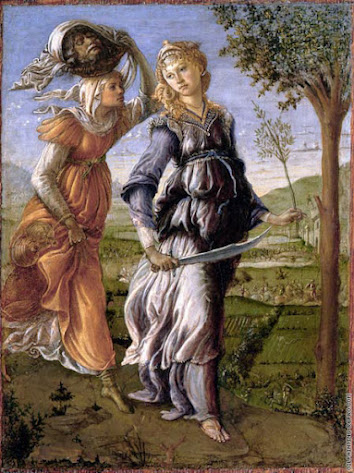Renaissance Blog Post: The Return of Judith to Bethulia
Sandro Botticelli was one of the most influential painters of the Renaissance. He was known for using bright colors, a delicate touch, and conveying a depth of emotion that made his work stand out. Connected with the powerful Medici family, Botticelli was one of the most sought after painters of his day. As a teenager, Botticelli was offered a studio space within the Medici palace itself, an honor that launched the rest of his career. He even managed to befriend Lorenzo and Giuliano Medici, the heirs to the family legacy. ("Medici: Godfathers Of The Renaissance. Botticelli | PBS")
Having a good relationship with the most powerful family in Florence ensured that Botticelli would have a successful career, and indeed he did. Over his lifetime, Botticelli created some of the most beautiful and well known paintings of the Italian Renaissance. The painting I have chosen to discuss today is not extremely well known, but it clearly displays Botticelli's skill and style.
The Return of Judith to Bethulia is a religious scene painted in 1472. It is a small painting, 31 x 24 cm, oil on a wood panel. ("The Return Of Judith To Bethulia By BOTTICELLI, Sandro")
To fully appreciate it, one must first be acquainted with the story behind it. The story of Judith and Holofernes is found in the apocryphal Book of Judith, which tells the story of a beautiful young widow, Judith, who lived in a city under siege by the Assyrian army. As the story goes, Judith knew her city could never stand against the Assyrians, so she took matters into her own hands. The Assyrian general, Holofernes, was infamous for getting drunk and chasing women, so she cleverly disguised herself as a courtesan and walked right into his camp. Struck by her beauty, Holofernes invited her into his tent. It was a fatal mistake. Judith was just as wise as she was beautiful, and kept him talking and drinking late into the night. Holofernes eventually fell into a drunken stupor, and Judith struck. She beheaded the general with his own sword while he lay asleep, and left the camp as quietly as she came. Thus, the bravery and wits of one woman saved an entire city and defied the most powerful empire of the time. ("The Return Of Judith To Bethulia By Sandro Botticelli: History, Analysis & Facts")
This powerful story was a common subject for Renaissance painters, including Botticelli. In fact, he painted Judith at least six times over the course of his career(Biagini, 2021). The Return of Judith to Bethulia shows Judith and her maid after making their escape. Judith still carries the bloody sword in one hand, and an olive branch in the other to symbolize peace. Her maid carries the bloody basket containing Holofernes' head atop her own head. Both women appear to be striding along in a hurry, with hair and skirts flying behind them. While the maid wears a determined, triumphant expression, Judith looks more thoughtful, even a little bit sad. Her gaze seems to drift behind her, as if she is contemplating what she has just done. Botticelli's skill in portraying emotion is clearly seen here. ("The Return Of Judith To Bethulia By Sandro Botticelli: History, Analysis & Facts")
Not only was Botticelli skilled at portraying realistic human figures and emotions, he also took care with the surrounding landscape. Behind Judith and her maid, we see the farmland, the city, water, and a clear sky speckled with clouds. The path they walk on appears to be made of stone with small plants growing along the sides. The bright colors he used makes the painting very attractive.
Overall, the emotion conveyed is one of triumph. The firm strides the women take, the bloody sword, the decapitated head, and the olive branch all help deliver a sense of victory over evil. However, Judith's serious and contemplative face reminds us that victory comes at a price. Taking a life is no small thing. However, the sky is clear, the farmland is green, lush, and full of life. Judith can return home to rest, knowing her city is safe.
I find this painting fascinating for several reasons. For one, the powerful story behind it makes the painting all the more impressive. When Botticelli's skill is applied, the story really comes to life, and I can almost see the two hurrying along to get back inside the safety of the city. Judith's clothing and jewelry are delicate, and her curly blond hair with a golden headband makes her look like a princess. However, the bloody sword she carries is a testament to her sheer willpower and strength. Judith is not a woman to be trifled with.
Bibliography:
Biagini, Julia. Sandro Botticelli’s The Return of Judith to Bethulia and The Discovery of the Body of Holofernes and the Experiences of Quattrocento Florence. Diss. Ohio University, 2011.
"The Return Of Judith To Bethulia By Sandro Botticelli: History, Analysis & Facts". Arthive, 2021, https://arthive.com/sandrobotticelli/works/4656~The_Return_of_Judith_to_Bethulia.
"The Return Of Judith To Bethulia By BOTTICELLI, Sandro". Wga.Hu, 2021, https://www.wga.hu/html_m/b/botticel/1early/12judith.html.
"Medici: Godfathers Of The Renaissance . Renaissance . Botticelli | PBS". Pbs.Org, 2021, https://www.pbs.org/empires/medici/renaissance/botticelli.html.



Wow! What an interesting story behind this art piece. Knowing the story behind it really makes it more appealing in my opinion. In addition to the story being less religious, you can also really see the Humanism in the expressions in both the women's faces and postures.
ReplyDeleteI loved reading your blog! I would agree that Botticelli does a beautiful job at conveying emotion in his painting. This is the first time I have heard of The Story of Judith. It's a story that supports the belief that one individual can make a difference. I enjoyed reading your description of emotions portrayed in the painting, and I can see the same emotions and story in the painting that you described.
ReplyDelete